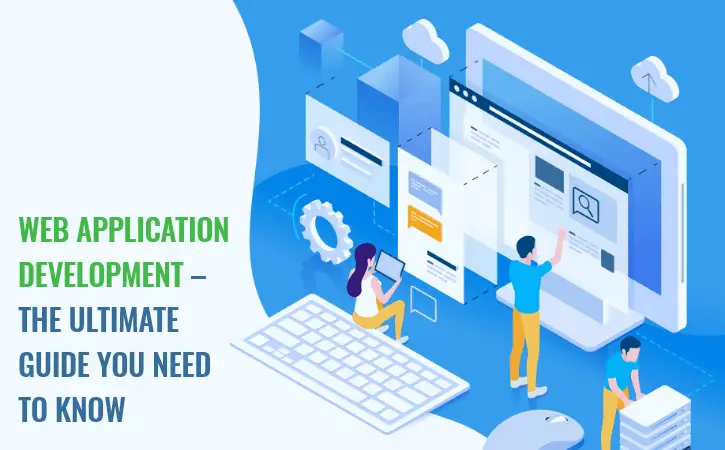The Future of Web Application Development

Whether it’s the cloud architecture or AI-based website builders, chatbots or Progressive web apps, artificial intelligence is changing the way we build web applications. These technologies have the potential to change how we do business and create new types of experiences. But before we jump into what’s coming next, we should examine how AI will affect today’s web development industry.
Cloud architecture
Cloud architecture for web application development allows enterprises to take advantage of multiple computing resources, which are not physically located on a company’s premises. The architecture is built upon a concept called data segmentation, or sharding. This technique separates the data to be processed into segments, and stores the result across several application servers.
The cloud is a powerful tool to manage and scale up web applications. This method allows organizations to achieve higher application performance with lower operating costs, while also providing satisfied end users. When implemented properly, cloud architecture can help organizations maximize their IT budget, future-proof their IT environment, and deliver high-quality applications. For optimal results, organizations must determine their computing capacity requirements before designing their cloud architecture.
A cloud-based web application consists of two parts: a front-end and a back-end. The front-end interacts with the server’s data storage, which is often hidden behind a cloud service provider’s firewall. The back-end cloud infrastructure manages resources and ensures a high level of security. It also protects data from loss and provides security management.
A distributed model is more reliable than a single web server. Distributed applications are built on two or more web servers, and even if one of them goes down, the other one will take over. In addition to improving reliability, distributed applications also reduce the risk of application downtime.
AI-based website builders
AI-based website builders are the future of the web application development industry, according to some experts. A website builder using artificial intelligence can generate several different designs with the click of a button. This allows the user to choose from the most appropriate one for their business. Users can also edit the site using drag-and-drop editor and customize any element as per their preferences.
A major advantage of AI-based website builders is that they can be customized to your specific needs. By analyzing data about your website and the user, it can provide necessary information and services. In addition, it can improve visitor participation by replying to their comments or blogs in real time. Furthermore, AI-based website builders can improve the uptime of your website.
With the rapid advances in technology, businesses can now better serve their customers. The adoption of AI-based website builders will help them increase their site’s load time and improve their ranking on search engine results pages (SERPs). As a result, it will be possible for websites to be ranked higher on voice search queries. Not only will this benefit customers, but it will also help businesses build brand loyalty and increase their brand value.
Companies like Grid Interactive are pioneers in integrating AI into web application development. Their latest AI named Molly is designed to make the process of designing a website much quicker and easier. The AI uses pictures, images, and answers to questions to create a customized website for users. It will then apply color schemes based on the users’ preferences and images. Using a five-color palette, the AI is capable of producing websites with 200,000 different variations.
Progressive web apps
Progressive web apps (PWAs) are the future of web application development, and they are an excellent way to improve mobile engagement and conversions. They are quick to implement, feature-rich, secure, and extremely light in weight. Even though they’re relatively new, the technology is already a great asset for business owners.
A progressive web app can run on any browser and is accessible offline. This means no app store install is required. It also provides a more consistent user experience across devices. And you can build these apps by yourself or with an in-house team. For a lower cost, you can build progressive web apps for mobile platforms, which are much cheaper than desktop platforms.
A progressive web app’s developers use an event-driven API called Service Workers to handle complex tasks. This API sits between the server and client and handles multiple processes at once. It also allows developers to manipulate detailed cache resources. A progressive web app’s metadata file can be updated and fixed to match changes made on the server side.
Progressive web apps are a powerful technology that will revolutionize web application development. These apps allow developers to create web apps that function similar to native apps. They’re easier to build and maintain, and they’re compatible with many platforms. Despite their advantages, progressive web apps are not perfect. While they don’t run on the same platforms as native applications, they’re still capable of providing an excellent user experience.
Chatbots
Incorporating chatbots into your web applications can save your company money and improve your customer service and internal processes. Companies can even use chatbots to help customers select products or process returns and exchanges. This technology is gaining popularity in ecommerce and is already being used by a number of brands.
Chatbots can handle customer queries in multiple languages. They can provide assistance 24 hours a day. A chatbot is available at all times and can answer a range of questions. Businesses can keep in touch with their customers round the clock, while also gaining new ones. With so many benefits, chatbots are the future of web application development.
Chatbots can provide a human-like conversational interface. The main benefits of chatbots in enterprise settings include the ability to gauge a person’s intent to buy, answer IT questions, and improve response time. Ultimately, chatbots are becoming an essential part of enterprise software, so it’s vital that developers understand the various challenges and requirements involved in implementing them.
With the rise of machine learning, chatbots will become more advanced. They can improve the user experience and improve communication between people, which is a major concern for companies today. With the help of chatbots, consumers can access information in one go, saving them time.
Multi-experience design
Multi-experience design means taking into account all of the touch points that a customer will interact with during a given experience. This can include a desktop, a laptop, augmented reality, and even virtual reality. In short, it means developing an application that is as functional and seamless across all touchpoints as possible.
The most popular application touchpoint today is the web, but other devices, such as smart speakers, are becoming increasingly popular. Thus, browser-OS-device fragmentation is a major issue in this industry. To accelerate the development of multi-experience apps, developers are increasingly making use of low-code/no-code platforms, which make building complex applications easier.
Moreover, multi-experience technologies aim to reduce friction and effort for the user and are customized to the environment and preferences of the end user. This helps improve business outcomes. According to Gartner, multi-experience technologies enable companies to develop and deploy targeted solutions for their internal and external constituencies.
Multi-experience design is becoming increasingly important for businesses, as consumers increasingly expect seamless experiences across all touchpoints. These experiences also require new tools and techniques. To create these experiences, developers need to follow new principles, which are based on three principles: context, technology, and culture.
The future of digital transformation is transforming the entire customer experience. It means shifting from mobile to multi-experience design, with the customer at the center of it all.
Push notifications
While push notifications are a good way to improve the usability of your web application, they should be used with caution. They should only be sent to users if they opt in to receive them. The same goes for users of Android devices, who automatically give permission to receive push notifications when they download an application.
Not all browsers support push notifications, but most major mobile and desktop browsers do. Push notifications are currently supported in Chrome, Firefox, Opera, and Safari. However, some browsers do not support rich media push notifications, so Android users may not get them. Android users may have to opt-out manually, but the Android platform has made this easier in recent years.
Using push notifications can help you achieve a number of business goals. Not only do they increase engagement, but they can be used as a powerful tool for sharing valuable content. Depending on the type of notification, you can even deeplink to a specific page on your website.
When it comes to notifications, automation is an important feature for organizations. This is especially true in cases where people need notifications quickly. While traditional email notifications are generally composed of plain text, push notifications can include images and call-to-action buttons. Not only are push notifications useful for mobile phones, but they can also be sent to desktops.




